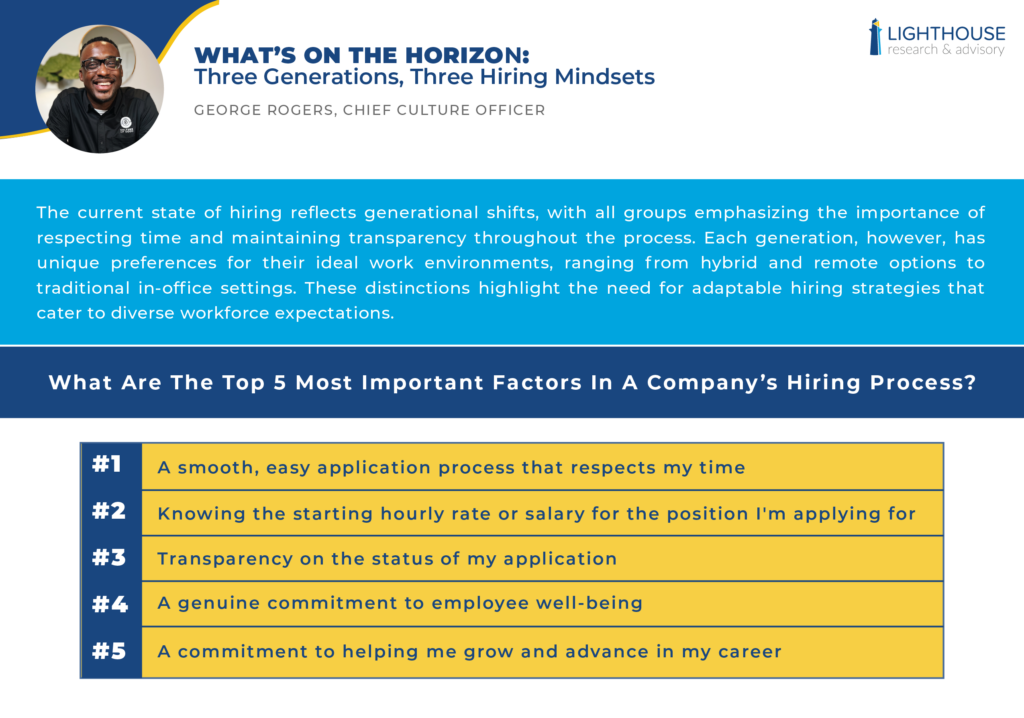Generational Views: Three Generations, Three Hiring Mindsets
In the current state of hiring, employers must navigate the preferences and expectations of diverse generations. By creating an adaptive hiring environment, businesses can bridge the GAP (Generational Adaptable Practices) and thrive. Here’s how:
G – Grow Relationships
Fostering strong relationships with potential employees is crucial across all age groups. Millennials often prioritize a sense of community and connection within their workplace. Establishing genuine connections early on, through personalized communication and interactive interview processes, helps build trust and makes candidates feel valued. Generation X values stability and professional growth. Employers can appeal to them by providing clear information about career progression and organizational culture. Meanwhile, Baby Boomers, many of whom are looking for a meaningful conclusion to their careers, appreciate respect and acknowledgment of their experience. Tailoring your approach shows that you value diverse perspectives and experiences.
A – Adaptable Work Environments
Each generation has distinctive preferences when it comes to their work environment. Hybrid or remote options are particularly appealing to Millennials, who often seek a balance between work and personal life. Generation X appreciates flexibility but also values face-to-face interactions that can enhance collaboration and learning. Baby Boomers, accustomed to traditional in-office settings, might still prefer this familiar structure. By offering a range of work arrangements, employers can demonstrate their commitment to accommodating different needs. An adaptable work environment promotes inclusivity and keeps the workforce motivated.
P – Provide Transparent Processes
Transparency throughout the hiring process is essential for earning trust and respect. Clearly communicating timelines, expectations, and outcomes helps candidates feel respected, regardless of their generation. Millennials particularly value prompt feedback and transparency about company values and practices. Generation X appreciates straightforward, honest communication about roles and responsibilities. Baby Boomers, with their vast experience, often seek clarity on how their potential roles align with long-term goals and organizational stability.
As you can see in the graphic above, the #1 factor in the hiring process is a smooth, easy application process that respects the employees time. Candidates who are searching for opportunities desire more than just transparency, they desire the same thing most employers are hoping that bring to the workplace and thats efficiency. Time is the greatest resource and maximizing the time is crucial to how they see your company. That’s why I believe implementing GAP – Growing relationships, offering Adaptable work environments, and ensuring transparent Processes – employers can create a positive hiring landscape for all generations. These practices show respect for the diverse work expectations of Millennials, Generation X, and Baby Boomers, leading to a more unified, versatile, and inspired workforce. Embracing generational differences can transform hiring strategies, creating a dynamic and inclusive environment where all employees can thrive.
Click the link below to see the full infographic from our new Talent Acquisition Study and Three Generations with Three Hiring Mindsets.
Talent Acquisition Three Generations 2025 Infographic

George Rogers is the Chief Strategy Officer at Lighthouse Research & Advisory. He is an author, coach, and globally renowned keynote speaker acclaimed for delivering compelling insights on cultivating purpose-driven, profitable businesses. As a leader developing inclusive and motivating workplace environments, he consistently provides transformative perspectives and guidance to organizations worldwide. Over the past two decades, he has dedicated himself to inspiring leaders and transforming workplace cultures.
In his book Champion Your Purpose, we learn that finding purpose in life looks different for everyone, and very few will find the exact common purpose that aligns the exact same. He provides a step-by-step approach to help readers identify their purpose and align it with their personal and professional goals.
His research focuses on leadership and its impact on performance, engagement, culture, mental health, inclusion, and belonging. If you ask him what led him to the HR space, he will remind you that his passion and purpose are championing people.
With over 25 years of leadership and keynote speaking experience, he has inspired, empowered, and challenged every audience —virtually and in person —to discover their purpose in the workforce, learn how to Champion Your Purpose individually, and lead the life they love.

